A comprehensive guide to installing the T4 thermostat, ensuring a smooth transition to efficient temperature control. This manual provides step-by-step instructions for a successful setup, emphasizing safety and optimal performance.
Overview of the T4 Thermostat
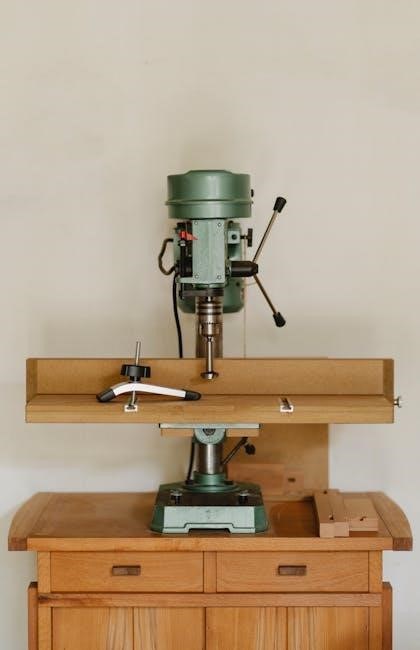
The Honeywell T4 thermostat is a programmable device designed for efficient temperature control. It features a sleek design, user-friendly interface, and compatibility with various HVAC systems. The T4 supports both heating and cooling systems, offering programmable modes and energy-saving options. It includes a wall plate for easy installation and can be powered via batteries or hardwired. The thermostat allows users to set schedules, override settings, and monitor energy usage. Its programmable modes enable customization to suit different lifestyles and preferences. The T4 is an ideal choice for homeowners seeking precise temperature control and energy efficiency with minimal complexity.
Importance of Proper Installation
Proper installation of the T4 thermostat is crucial for ensuring safety, optimal performance, and energy efficiency. Incorrect installation can lead to inaccurate temperature readings, system malfunctions, or even safety hazards. Following the manufacturer’s guidelines guarantees that the thermostat functions correctly, providing precise control over your heating and cooling systems. It also ensures that all advanced features, such as programmable modes and energy-saving settings, operate effectively. Proper installation prevents potential issues like short circuits or improper wire connections, which could damage the thermostat or your HVAC system. Always refer to the installation manual and consider consulting a professional if unsure.
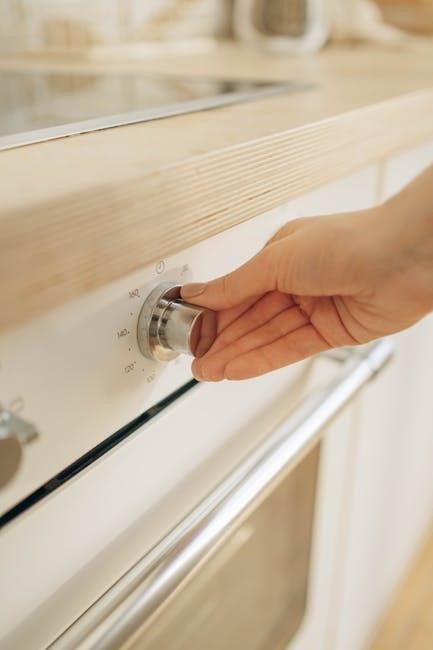
Preparation for Installation
Before starting, ensure power is disconnected, gather necessary tools, and verify system compatibility. Review the manual and prepare the area for a smooth installation process.
Tools and Materials Required
To install the T4 thermostat, you’ll need a screwdriver, pliers, wire strippers, and a drill. Additional materials include the thermostat unit, wall plate, UWP mounting system, screws, and AA alkaline batteries. Ensure all components from the packaging are accounted for, and refer to the wiring diagram in the manual for specific connections. Having a voltage tester on hand is also recommended for safety. Organize these tools and materials beforehand to streamline the installation process and avoid delays. Proper preparation ensures a smooth and efficient setup of your T4 thermostat.
Understanding System Compatibility
Before installing the T4 thermostat, ensure it is compatible with your HVAC system. The T4 works with 24V heating, cooling, and heat pump systems but is not compatible with 230V electric heating. Verify your system type (gas, electric, or heat pump) and check the wiring configuration. Refer to the manual to confirm compatibility and wiring requirements. If unsure, consult a professional to avoid installation issues. Proper system compatibility ensures optimal performance and safety. Always follow the manufacturer’s guidelines for a seamless integration with your existing heating and cooling setup.
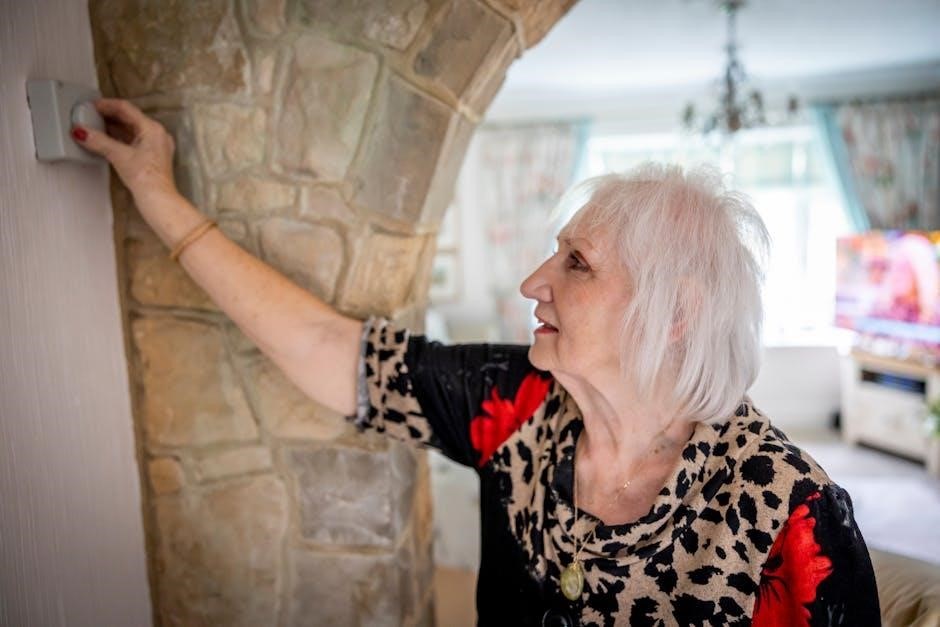
Installation Process
The T4 thermostat installation involves disconnecting power, removing the old thermostat, mounting the wall plate, connecting wires, and attaching the thermostat. Follow safety precautions and instructions carefully to ensure a successful setup.
Disconnecting Power and Safety Precautions
Before starting the installation, ensure the power to your HVAC system is completely disconnected. Verify this by checking that the heating or cooling system is turned off. Locate the circuit breaker or switch controlling the system and turn it off. Double-check that the system is powered down to avoid any accidental start-ups. Additionally, ensure the furnace door is closed securely and that fresh AA alkaline batteries are installed in the thermostat if required. Always handle electrical components with caution, and if unsure, consult a licensed professional. Safety precautions are critical to prevent electrical shocks or system damage during the installation process.
Removing the Old Thermostat
Begin by carefully separating the thermostat from the wall plate. Gently pull the thermostat away from the wall to access the wiring behind it. Open the terminal cover on the wall plate using a screwdriver to expose the wires. Disconnect each wire from the old thermostat, taking note of their colors and positions for future reference. Once all wires are free, remove the old thermostat from the wall plate. Ensure no wires remain connected to the old unit to avoid damage. If the old thermostat is hardwired, double-check that the power is off before proceeding. Remove any excess wiring carefully to prepare for the new installation.
Mounting the Wall Plate
Locate the wall plate and ensure it is properly aligned with the wall studs or mounting points. Gently push any excess wiring back into the wall opening to keep it organized. Close the UWP (Universal Wall Plate) door, ensuring it lies flat and does not bulge. Align the wall plate with the marks made during preparation, then secure it using the provided screws. For drywall, use drywall anchors if necessary. Tighten the screws firmly but avoid over-tightening, which could damage the plate. Once mounted, double-check that the wall plate is level and securely attached to the wall.
Connecting Wires to the Wall Plate
Open the wall plate terminal cover using a screwdriver to access the wire connections. Carefully align the wires with their corresponding terminals, referring to the wiring diagram in the manual. Match the colored wires to their designated slots (e.g., R, W, Y, G, C) to ensure proper functionality. Secure each wire firmly into its terminal, making sure there are no loose connections. Once all wires are connected, gently push any excess wiring back into the wall to maintain a clean installation. Close the terminal cover and ensure it is securely fastened to protect the connections.

Attaching the Thermostat to the Wall Plate
Remove the battery tab from the thermostat to activate it. Align the thermostat with the wall plate, ensuring proper fitment. Gently clip the thermostat onto the wall plate until it securely snaps into place. Ensure the device is level and evenly aligned for optimal functionality. Once attached, verify that all connections are stable and the thermostat is firmly mounted. This completes the physical installation, allowing you to proceed with configuration and testing.

Configuring the Thermostat
Configure your T4 thermostat for optimal performance by setting up initial preferences, adjusting heating and cooling settings, and programming schedules to match your daily routines.
Setting Up the Thermostat for the First Time
After installation, insert fresh AA alkaline batteries into the thermostat. Ensure the system is compatible with your HVAC setup. Press and hold the CENTER button to access the advanced menu, navigating through options to configure basic settings. Perform a quick functional test to verify proper operation.
Configuring Heating and Cooling Settings
Use the Plus and Minus buttons to navigate through the menu and set your preferred temperature range. Adjust the heating and cooling differential to ensure efficient operation. Set the system changeover mode to match your HVAC setup. Test the system by switching between heating and cooling modes to ensure proper functionality. Make sure the temperature setpoints are within the recommended range for your system. Refer to the wiring diagram for specific configurations. After configuring, perform a quick test to verify that the system responds correctly to temperature adjustments. This ensures optimal performance and energy efficiency for your home comfort system.
Setting Up Schedules and Preferences
Access the menu by pressing and holding the CENTER button, then navigate to the schedule settings using the Plus or Minus buttons. Set your preferred heating and cooling schedules for different days of the week. Choose from pre-programmed templates or customize your own. Adjust the temperature setpoints to match your comfort preferences. Enable energy-saving modes to reduce energy consumption during off-peak hours. Save your settings to ensure they are applied. Test your schedule by simulating different times of the day to verify proper operation. This step ensures your thermostat operates efficiently and aligns with your daily routine for optimal comfort and energy savings.

Advanced Features and Settings
Explore programmable modes, energy-saving features, and override functions to customize your T4 thermostat experience, optimizing comfort and efficiency with advanced temperature control capabilities.
Understanding Programmable Modes
The T4 thermostat offers programmable modes to customize heating and cooling schedules, enhancing comfort and energy efficiency. Manual mode allows permanent schedule disabling, while automatic mode switches between heating and cooling based on settings. Timed override enables temporary adjustments without altering the main schedule. Installer Setup (ISU) configurations, like ISU 205, determine system operation modes, such as Electric Forced Air or Fan Coil. These modes ensure the thermostat adapts to your lifestyle and HVAC system requirements. Properly configuring these settings optimizes performance and energy savings, making the T4 thermostat a flexible solution for various home environments and user preferences.
Enabling Energy-Saving Features
The T4 thermostat includes advanced energy-saving features to optimize your heating and cooling usage. Enable automatic changeover to switch between heating and cooling modes based on temperature settings. Smart recovery learns your system’s operation to preheat or cool, reducing energy waste. Use the energy usage report to monitor and adjust consumption patterns. These features, combined with programmable schedules, help lower utility bills while maintaining comfort. Accessing these settings through the thermostat’s menu ensures eco-friendly operation without compromising performance. Proper configuration of these modes maximizes efficiency, making the T4 thermostat a cost-effective and environmentally friendly choice for modern homes.
Using the Override Function
The T4 thermostat’s override function allows temporary adjustments to your heating or cooling schedule without altering the programmed settings. To activate it, press and hold the “Override” button until the screen confirms the change. You can manually set the desired temperature, and the system will maintain it until the next scheduled period begins. This feature is ideal for unexpected changes in your routine or comfort needs. The override function ensures flexibility while preserving your energy-saving schedules. Use the “+” or “-” buttons to adjust the temperature during the override mode. The thermostat will revert to its programmed settings automatically at the next scheduled time, ensuring uninterrupted energy efficiency and convenience.
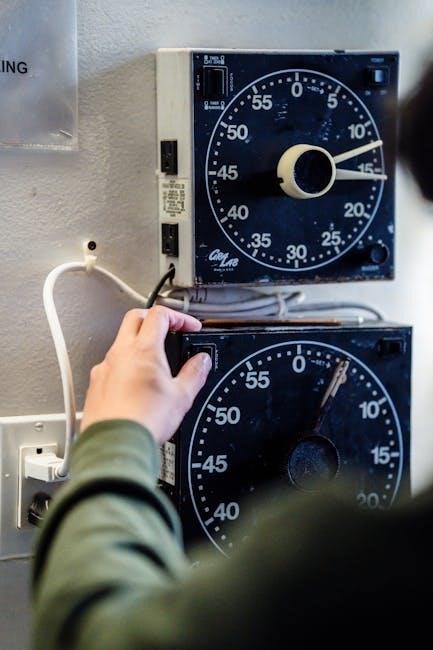
Troubleshooting Common Issues
Identify and resolve issues with your T4 thermostat by checking power, connections, and settings. Replace batteries, ensure proper wiring, and verify system compatibility for optimal performance.
Blank Screen or No Power
If your T4 thermostat displays a blank screen or has no power, first check the batteries. Ensure fresh AA alkaline batteries are correctly installed. Verify that the power switch for your heating or cooling system is turned on. Also, confirm that the furnace door is securely closed, as an open door can disable power to the thermostat. If the issue persists, inspect the wiring connections for any loose or damaged wires. Refer to the manual for specific troubleshooting steps. If the problem remains unresolved, contact a professional installer or Honeywell customer support for assistance.
Incorrect Temperature Readings
If your T4 thermostat shows incorrect temperature readings, first ensure the sensor is functioning properly. Check for any obstructions near the thermostat that could block accurate temperature detection. Verify that the thermostat is installed in a location that reflects the average temperature of the room. If the issue persists, recalibrate the thermostat by navigating to the advanced settings menu and following the calibration process. Ensure all HVAC system components are working correctly. If the problem continues, consult the user manual or contact Honeywell support for further assistance to resolve the issue and restore accurate temperature readings.
Thermostat Not Responding to Commands
If the T4 thermostat is unresponsive, first ensure it has power. Check circuit breakers or fuses to confirm the system is energized. Verify that all wiring connections are secure and correct, as loose wires can disrupt functionality. Restart the thermostat by removing and reinstalling the batteries (for wireless models) or resetting the power supply. If issues persist, perform a factory reset by holding the center button for 5 seconds. Ensure the thermostat is properly paired with the wall plate and that no obstacles block communication. If the problem remains, consult the user manual or contact Honeywell support for assistance.
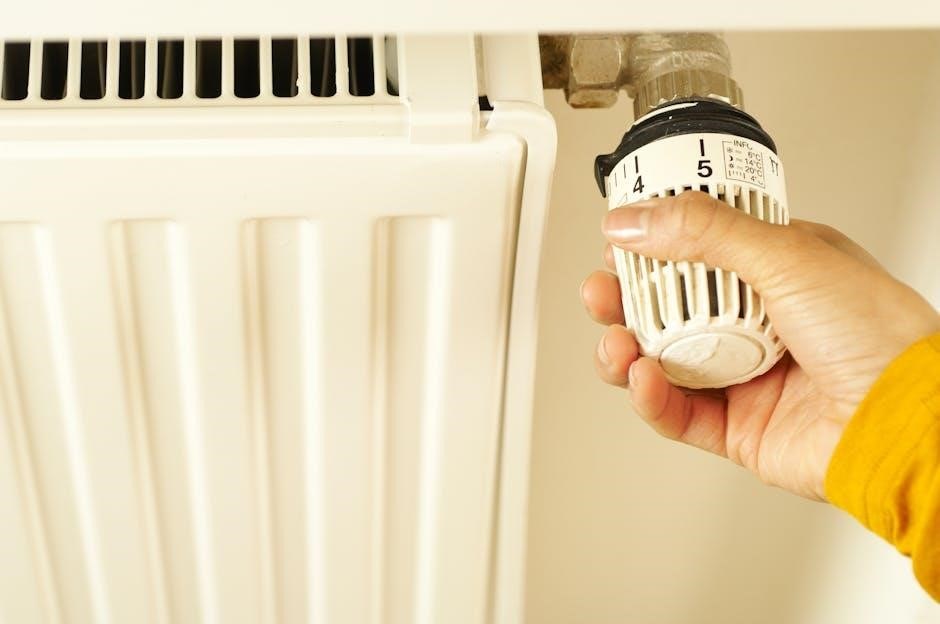
Maintenance and Care
Regularly clean the thermostat screen and check battery levels. Replace batteries annually or when low. Update software periodically for optimal performance and new features.
Cleaning the Thermostat
Regular cleaning ensures accurate temperature readings and optimal performance. Use a soft, dry cloth to gently wipe the thermostat’s screen and exterior. Avoid harsh chemicals or liquids, as they may damage the device. For stubborn marks, lightly dampen the cloth with water, but ensure no moisture enters the thermostat. Check for dust or debris around the sensors or vents, as these can interfere with functionality. Cleaning should be done monthly or whenever visible dirt accumulates. Proper maintenance helps maintain efficiency and extends the lifespan of your T4 thermostat.
Replacing Batteries
To ensure uninterrupted operation, replace the batteries when the thermostat indicates low power. Use fresh AA alkaline batteries for optimal performance. Power down the thermostat before replacing batteries to avoid any system glitches. Open the battery compartment, typically located on the back or bottom of the device. Remove the old batteries and insert the new ones, ensuring correct polarity. Close the compartment securely. After replacement, check the thermostat’s display to confirm it powers on. Test the system by adjusting the temperature to ensure proper functionality. Regular battery replacement maintains accurate temperature control and prevents system malfunctions.
Updating Software or Firmware
Regular software or firmware updates ensure your T4 thermostat operates with the latest features and security patches. To update, navigate to the settings menu and check for available updates. If an update is found, follow on-screen instructions to download and install it. Some models may require a USB connection, while others can update wirelessly. Visit the official Honeywell website to download the latest firmware version if needed. After updating, restart the thermostat to apply changes. Ensure the system is fully functional post-update by testing temperature adjustments and scheduling features. Updating maintains optimal performance and resolves any potential software issues.
Verify all functions operate correctly, ensuring temperature accuracy and schedule adherence. Perform a final safety check to confirm proper installation and system operation. Test all features thoroughly.
Verifying Proper Functionality
After installation, turn on the heating and cooling systems to ensure the thermostat responds correctly. Check temperature accuracy by comparing the display with a reliable thermometer. Test the override function to confirm manual adjustments work. Verify that schedules and preferences are functioning as programmed. Ensure the thermostat turns the system on and off at the set times. If connected, test remote sensors or external devices for proper communication. Finally, review all settings to confirm they match your preferences and system requirements. A thorough verification ensures the thermostat operates efficiently and meets your comfort needs.
Final Safety Checks
Ensure the power to the heating and cooling system is turned off before starting any work. Verify that all wires are securely connected and no loose ends are present. Check that the furnace door is closed properly and the system switch is in the “on” position. Confirm that fresh batteries are correctly installed if the thermostat is battery-powered. Ensure the thermostat is mounted level and securely fastened to the wall. Double-check that the override function operates correctly and that all safety features are enabled. Finally, review the installation manual to ensure all safety guidelines have been followed for a safe and efficient setup.

Additional Resources
Visit the official Honeywell website to download the full T4 thermostat installation manual. It includes detailed guides, troubleshooting tips, and contact information for customer support assistance.
Downloading the Full Manual
To access the complete Honeywell T4 thermostat installation manual, visit the official Honeywell website. Navigate to the support section and search for the T4 model. Download the PDF guide, which includes detailed installation steps, wiring diagrams, and troubleshooting tips. Ensure compatibility with your device before proceeding. The manual provides comprehensive instructions for configuring advanced features and addressing common issues. Refer to it for a seamless installation process and optimal thermostat performance.
Contacting Customer Support
For assistance with your T4 thermostat, visit Honeywell’s official website and navigate to the support section. Use the ‘Contact Us’ feature to reach customer service via email or phone. Provide your thermostat model and issue details for prompt help. Additionally, access the Honeywell Home app or website for troubleshooting guides, FAQs, and software updates. Ensure your device is registered for warranty support. Customer service is available to resolve installation, configuration, or operational issues, ensuring your T4 thermostat operates efficiently. For urgent matters, call the dedicated support hotline listed on the Honeywell website.
